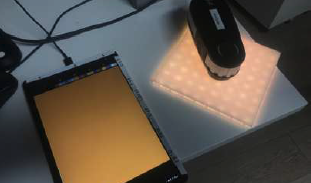
For a few years, the automotive industry has produced new cars with continuous changing display models, this by combining display sizes, forms, and technologies all together to bring new experiences to the users. In this paper we will present the color matching solution implemented for a new car display system where regular LCD display technology and LED lighting tiles are mixed together. The solution we proposed is based on accepted display model providing the transformation device RGB space to CIE XYZ independent color space and in reverse. The approach we followed choose the LCD display as reference, then transformation matrix is derived to modify the RGB LED control values. Once the color matching operation is applied, the color difference between the two display areas is greatly reduced.

Self-driving cars are gradually making their way into road traffic and represent the main component of the new form of mobility. Major companies such as Tesla, Google, and Uber are researching the continuous improvement of self-driving vehicles and their reliability. Therefore, it is of great interest for trained professionals to deal with and understand the principles and requirements for autonomous driving. This paper aims to describe the new concept of a Bachelor / Master level university course for automotive technology students to address new mobility and self-driving cars. For the practice-oriented course, hardware in a low budget range (US $80) was used, which nevertheless has all the necessary sensors and requirements for a comprehensive practical introduction to the topic of self-driving automotive technology. The modular structure of the course contains lectures and exercises on the following topics: The first Exercise deals with the construction and modification of the Car-Kit, followed by the setup of the used Raspberry Pi. Since the car kit and Raspberry Pi are ready to use, the third exercise will steer the car remotely. The autonomous lane lectures and exercises follow this navigation with color spaces and masking, the Canny edge detection, Hough transform, steering, and stabilization.

Will autonomous vehicles ever be able to drive around safely? In Germany lane markers on streets are white. In construction zones temporary markers are installed on top of the standard ones that are yellow and they direct the traffic e.g. into shifted lanes. So, the only differentiation is the color. But what about the white markers at times close to the sunset? Then we drive into Austria and the temporary markers are turning orange. Or driving in the US makes the whole country a construction zone because markers are always yellow. Automotive cameras are often times not RGB cameras. They have other color filters to maximize sensitivity, which often times does not help differentiating colors. So does the spectral reflectance matter? Which impact does the illumination have? And there are many different ones like daylight at different times of the day, different kinds of streetlights, different headlights of the cars etc. Traffic signs create another color problem. We drive from Switzerland to France. In Switzerland the freeway signs are green and the major road signs are blue. When you cross the French border, it is the other way around. How can these problems be solved?

There are many test charts and software to determine the intrinsic geometric calibration of a camera including distortion. But all of these setups have a few problems in common. They are limited to finite object distances and require large test charts for calibrations at greater distances combined with powerful and uniform illumination. On production lines the workaround for this problem is often times the use of a relay lens which itself introduces geometric distortions and therefore inaccuracies that need to be compensated for. A solution to overcome these problems and limitations has originally been developed for space applications and has already become a common method for the calibration of satellite cameras. We have now turned the lab setup on an optical bench into a commercially available product that can be used for the calibration of a huge variety of cameras for different applications. This solution is based on a diffractive optical element (DOE) that gets illuminated by a plane wave generated with an expanded laser diode beam. In addition to the conventional methods the proposed one also provides the extrinsic orientation of the camera and therefore allows the adjustment of cameras to each other.